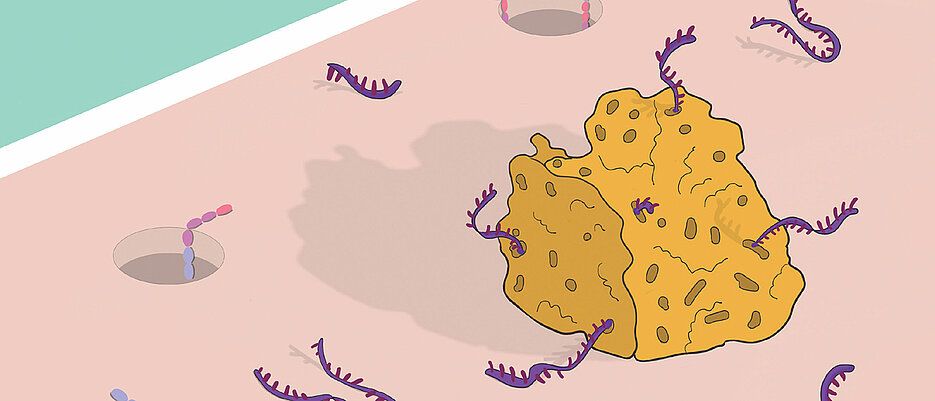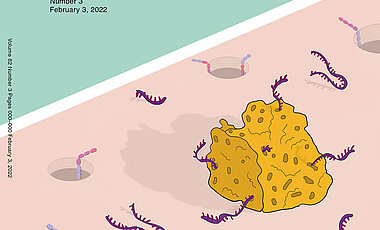A sponge playing in defence
02/03/2022Bacteria are extremely resourceful when it comes to adapting to a given environment. A team of researchers from Würzburg has now discovered a new trick bacteria use: a kind of sponge that absorbs certain messengers.
Each year, at least 1.27 million people die from an infection with bacteria that are resistant to standard antibiotics, a study recently published in the journal The Lancet reveals. The authors fear that this number could rise to as many as ten million people by 2050.
This makes the hunt for new substances that are effective against resistant bacterial strains more urgent than ever. A potential approach focuses on programmable RNA-based antibiotics. However, this requires an in-depth understanding of the key RNA-based signalling pathways and mechanisms during an infection.
New signalling pathways identified
This is the subject of research at the Institute for Molecular Infection Biology (IMIB) of the University of Würzburg and at the Helmholtz Institute for RNA-based Infection Research. Researchers in the laboratory of Professor Jörg Vogel, who holds the Chair of Molecular Infection Biology I at JMU and Managing Director of the HIRI, have figured out new details of these signalling pathways and mechanisms. They present the results of their study in the latest issue of the journal Molecular Cell.
Gianluca Matera, a Ph.D. student at the IMIB, provides more information on the background of the paper he co-authored with Jörg Vogel, saying: „A lot of bacteria, such as Escherichia coli and Salmonella enterica, have a cell envelope consisting of an outer and an inner membrane. The main function of this envelope is to shield the bacteria from their environment but it also has to be permeable for nutrients which the bacteria need to thrive".
A previously unknown player
Numerous RNA entities interact in order to manage which substances can pass through the cell envelope and which are blocked at a given time, the latter allowing the bacteria to protect themselves against antibiotics, for example. The researchers have now identified a previously unknown protagonist in the bacterium Salmonella enterica: an "RNA sponge".
Such sponges belong to the class of "small RNAs". The Würzburg study shows that the RNA sponge OppX mimics the actual binding target of a special sRNA, the so-called MicF sRNA, in the bacterial outer membrane, intercepting it before it reaches its destination. Or in other words, it absorbs it like a sponge.
Communication of the membranes
The MicF sRNA plays a crucial role in the processes of the bacterial envelope. "The outer and inner membrane of the bacterial envelope cannot work independently from one another. So there have to be mechanisms that enable them to communicate with each other. Small non-coding RNAs, such as MicF, are one class of such regulators," Gianluca Matera explains. Using a new technique developed at the Hebrew University of Jerusalem, the junior scientist has now identified the interacting partners of all these sRNAs in Salmonella – comprehensively and in a single step.
The researchers are capable of describing the effect of this interception process in detail: "Normally, OppX increases membrane permeability by boosting the expression of one of the main pores in the bacterial outer membrane," Matera specifies. This scientific name of this pore is OmpF.
If the bacterium lacks the OppX sponge, its growth will be restricted, especially in a nutrient-poor environment. If, however, sufficient amounts of OppX are available, the OmpF pores in the membrane also become more active, increasing the uptake of nutrients if they are scarce.
Indirect impact on antibiotics
The OmpF pores also assume a key function when the bacteria are attacked by antibiotics: The substances use them as their main points of entry into the cell. "Indirectly, OppX could have an impact on antibiotic efficacy by boosting OmpF production and thus the uptake of the antibiotic itself," Matera says.
OppX is the first known regulator of MicF activity – the recently published data even supports the assumption that OppX is the most important, if not the only, sponge for the MicF sRNA. Therefore, knowing it is crucial to fully understand the cellular activity of MicF according to the authors of the study.
These new findings are based on studies of bacteria grown in vitro under laboratory conditions. The scientists believe that the next challenge will be to extend these studies to more "realistic" conditions. The first step in this direction has already been taken: "We are currently decoding the RNA interactome of Salmonella in infected host cells," Jörg Vogel explains. "Antibiotic resistance is one of the major health threats of our time - that's why our basic research strives to contribute to the development of new therapeutics."
Original publication
Global RNA interactome of Salmonella discovers a 5’ UTR sponge for the MicF small RNA that connects membrane permeability to transport capacity. Matera G, Altuvia Y, Gerovac M, El Mouali Y, Margalit H, Vogel J (2022). Molecular Cell, https://doi.org/10.1016/j.molcel.2021.12.030
Contact
Prof. Dr. Jörg Vogel, Helmholtz Institute for RNA-based Infection Research, +49 931 31-82575, joerg.vogel@uni-wuerzburg.de
Matera Gianluca, Institute for Molecular Infection Biology, T: +49 931 31-86936, gianluca.matera@uni-wuerzburg.de








